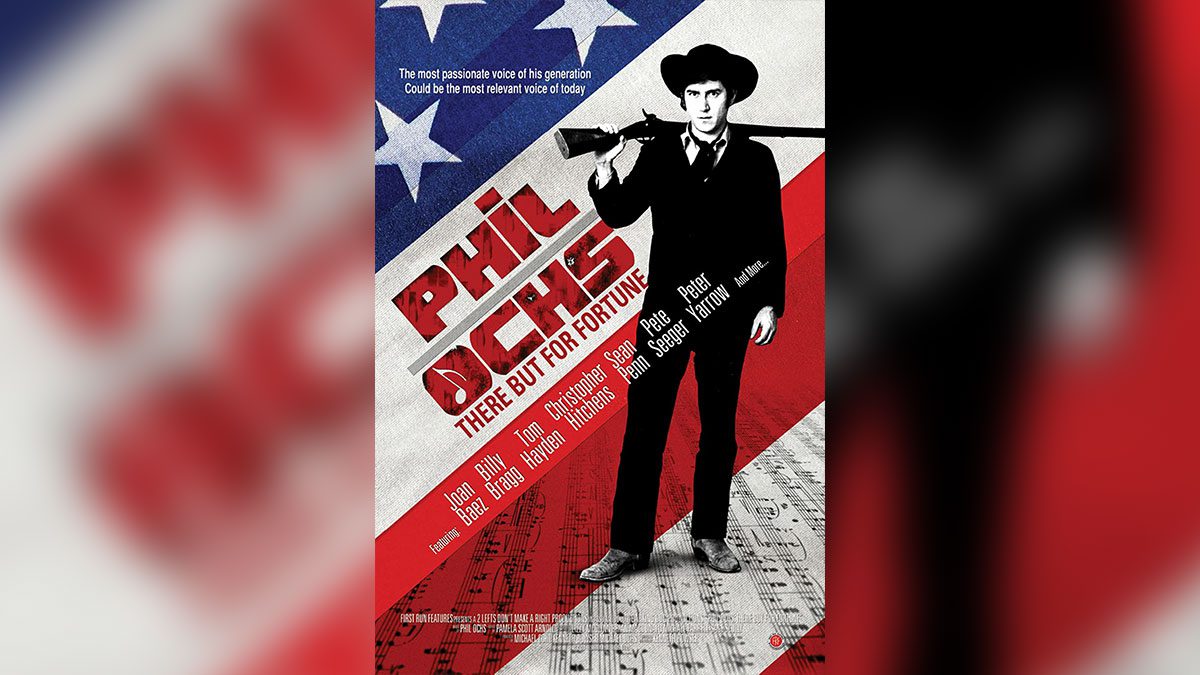From the May 2011 issue of The Socialist Standard
Phil Ochs as the Sound of the “New Left”
A new documentary film on the life and music of Phil Ochs, “There But For Fortune”, is being shown in several US cities now. It hasn’t come too soon, certainly, because Ochs today is largely unknown outside the circle of lefty baby-boomers.
Often Ochs is dismissed as a “topical” songwriter whose music, for that reason, hasn’t stood the test of time. “He’s no Bob Dylan,” his critics sometimes say. Dylan himself famously told Ochs he was “just a journalist” (as he threw him out of his limousine).
This image of Ochs owes much to his own statements, for he frankly admitted that the pages of newspapers and magazines were a source of songs ideas, saying “every headline is a potential song.” He underscored this by naming his first album “All The News That’s Fit To Sing” – punning on the masthead of The New York Times.
The origin of a song hardly determines its value, though; and in his best political songs, Ochs cultivated poetry out of such pulpy fertilizer, just like Hank Williams finding song ideas from his sister’s True Romance comic books.
Whatever one thinks of his music, though, it was clearly linked to the 1960s New Left movement. Ochs’s musical career rose with the movement, his songs championed its causes, and by the time of his suicide in 1976 the movement was dead as a social force. Listening to Ochs’s albums today is a way of tracing the rise and fall of this radical (but reformist) political movement.
Folk Re-revival
The combative optimism of the New Left movement in the days when it was still new comes across on Ochs’s first two albums (1964–65). In particular, his song “What’s That I Hear” gives listeners an idea of the excitement young leftists felt as fifties conservatism gave way to sixties radicalism, with Ochs describing the sound, off in the distance, of “freedom calling” and the “old ways falling”.
Ochs in those early albums is not only looking forward with confidence, but also looking back to see what can be salvaged from the radical past. He had first encountered the history of the radical left in the late fifties through his university roommate Jim Glover, a folk musician who unlike Ochs had been raised in a leftwing family.
The early song “Links On The Chain” shows Ochs contrasting radical past with conservative present, as he compares complacent trade unionist with the militants who formed the unions – and with the civil-rights activists of the time “All that they [activists] are doing is all that you have showed / That you gotta strike, you gotta fight to get what you are owed.”
What Ochs and the New Left did not learn from the history of leftwing radicalism, unfortunately, was its limits: how it never truly sought to replace this social system in which workers continually have to fight just to “get what they are owed”. The sixties radicals were thus doomed to travel down the same dusty reformist road the “old left” (Communist Party) had trodden before. Ultimately, the line separating old left and new left was a generational difference in style and temperament, not a true distinction between reformist and revolutionary politics.
The early sixties “folk revival” owed much to the old left and its earlier revival of folk music in the 1930s. The best way to understand the politics of the earlier folk musicians is to listen to the songs of Woody Guthrie as well as the Almanac Singers – a band that included Guthrie, Lee Hays, Pete Seeger, Josh White, and others. These musicians stuck to the CP line through thick and thin – and they started sounding pretty thick after 1941, when they ditched their (good) antiwar songs for crass warmongering songs like Pete Seeger’s horrifyingly awful “Dear Mr. President”. But even at their political and artistic best, the old-left songs glorify the futile effort to fundamentally reform capitalism.
“Sis” Cunningham, one of the Almanac Singers, and her husband Gordon Friesen took Ochs under their wing when he arrived in Greenwich Village in 1962. That was the year the couple started their soon-to-be influential magazine Broadside, which brought Ochs to wider attention by publishing the lyrics and music to his songs.
Ochs was influenced by Woody Guthrie, as Bob Dylan and so many others were, but he never tried to imitate Guthrie’s folksy ways (as Dylan does at times on his debut album). Rather, Ochs was drawn to Guthrie’s approach of using contemporary struggles as songwriting material and expressing a clear political opinion. This approach comes through on Ochs’s tribute to Guthrie, “Bound for Glory”, which culminates with the lines: “Why sing the songs and forget about the aim / He wrote them for a reason why not sing them for the same.”
Radical Reformist
Ochs was a reformist, as is clear from his songs, but of the radical persuasion. He bandied about the word “revolution” at times and had little patience for timid leftists. Ochs put down such types for all time in his brilliant song “Love Me I’m A Liberal”, where his stereotypical (but true to life!) liberal pleads with radicals like Ochs: “Don’t talk about revolution / That’s going a little bit too far.”
It was the revolutionary act of tearing down a rotten system – more than the question of what might replace it – that seemed to fascinate New Left radicals at times. In the song “Ringing of Revolution,” Ochs brilliantly depicts members of a once arrogant ruling class cowering before the irresistible power of a revolutionary uprising. What the revolution aims to accomplish, however, is anyone’s guess.
“The movement is everything, the final aim is nothing” (Bernstein) – this was the basic attitude of sixties activists. And “the movement” then mainly comprised the struggle for civil rights and the growing opposition to the Vietnam War. These two political issues inspired Ochs to write numerous songs.
On his early albums, Ochs often relied on satire to skewer racists and warmongers. “Whenever there is a deep tragedy, there is always something of the ridiculous,” is how Ochs once introduced to an audience his song “Talking Birmingham Jam”. For that song and other topical ones like it, Ochs borrowed the “talking blues” format that Guthrie had used. In some of his best satirical songs, Ochs has the target of the satire do the talking, like the pro-war hypocrite in “Draft Dodger Rag” who knows that “somone’s gotta go over there [Vietnam], and that someone isn’t me”.
The absurdity of war and racism also inspired some of Ochs’s most mournful songs (“Too Many Martyrs” and “Song of a Soldier”), as well as his angriest and most rousing songs (“Here’s to the State of Mississippi” and “One More Parade”). Listening to the variety of songs that the two burning political issues in the 1960s inspired him to write pokes holes in the assumption that topical or political music is a limited art form.
The sheer amount of energy that Phil Ochs derived from, and poured into, the two political movements, however, could only be sustained as long as the movements were still gathering strength.
New Left Grows Old
I don’t know / But it seems that every single dream’s / Painted pretty pictures in the air / Then it tumbles in despair / And it starts to bend /Until by the end it’s a nightmare (“Cross My Heart”).
Songs on his later albums, like this one from the 1967 album “Pleasures of the Harbor”, document how Ochs’s radical élan gave way to despair in the late sixties. At times, Ochs tries to buck himself up, as in the refrain to “Cross My Heart” where he pledges: “But I’m gonna give all that I’ve got to give / Cross my heart and I hope to live.” These half-hearted lines, among the clumsiest he ever wrote, could hardly have raised his morale. Now they seem poignant, though, knowing as we do the suicidal end of his story.
The mental turmoil of Phil Ochs in the late sixties seems to have resulted from a number of different but interrelated crises. His musical career was foundering, he sensed that his youth had become a memory, and he had always been in tune with the melancholic side of life (as even his earliest songs attest).
On top of this, or perhaps at the bottom of things, was the fact that the radical political movement was no longer in its optimistic early stage. The Vietnam War was widening despite the growth of protests against it, and every year brought new assassinations of civil rights leaders. The frustrations of radicals crystallized with the 1968 demonstrations at the Democratic national convention. Chicago police beating down the protesters came as a shock of disillusionment, leading the more impatient and imbecilic radicals to begin toying with terrorism.
Phil Ochs was in Chicago that summer for the convention and witnessed the “police riot” during the Yippie’s Festival of Youth in Lincoln Park. The 1968 event seemed to dissolve the remaining political optimism of Ochs, who was supporting the presidential candidate Eugene McCarthy.
The following year he released an album pessimistically titled “Rehearsals for Retirement,” featuring a cover photo of his own gravestone, with the inscription: Phil Ochs (American) Born: El Paso, Texas, 1940, Died: Chicago, Illinois, 1968. The events in Chicago marked his own “spiritual death,” Ochs felt.
It is rather simplistic to imagine that the police brutality in Chicago suddenly dissolved Ochs’s optimism. More likely, it occurred at point when he already felt that he was reaching a dead end as a musician and an activist, and was looking for a new way forward. (Sadly, the music industry and his own fans at the time did not embrace his later songs, which are among his best.)
Ochs did not abandon leftwing politics after 1968, but the thrill of activism was gone. And how could his radical enthusiasm have persisted without any real belief in the possibility of a post-capitalist society? The movement was everything for Ochs in the early sixties; and he had thought it could broadly reform American society. Even in those years, though, Ochs sensed the fragility of the reform movement and recognized the power of the “establishment”, as is reflected in the many early songs he wrote about martyrs. Perhaps Ochs imagined a glorious defeat for himself, which is the ultimate goal when the final aim is nothing.
He did not die in Chicago, though, and the New Left kept going too. A few years later they discovered that it was not glorious defeat but a pyrrhic victory that awaited them. The end of the Vietnam War may have been the victory of the antiwar movement, in a sense, but it was the end of the New Left. Opposing the war was everything to the movement, so its end left activists without a sense of purpose.
But capitalism continued. Later the US government would pluck up enough courage to wage new wars, and the problems of racism and poverty never went away. So a new “new left” could rise to fight the same struggles again. Some point to these familiar problems to demonstrate the “relevance” of Phil Ochs’s music today. “Just change a few names and places,” they say, “and the songs become contemporary.” Yes, quite true. But the same old capitalist problems popping up, again and again, despite the best efforts of activists like Ochs, really speaks to the utter irrelevance of reformism.
Ochs’s reformism is clear from his songs, but even those songs most clearly inspired by New Left ideas have lines that can sound revolutionary to socialist ears, straining to hear the sound of freedom calling and the old ways falling.
Michael Schauerte (WSPUS)



